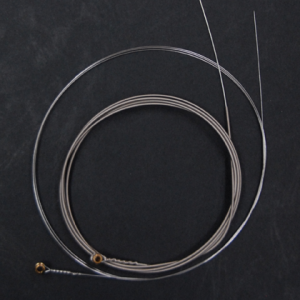
As with steel-stringed acoustics, electric guitars use steel strings, too. And as electric guitars are so popular, there are many types of electric guitar strings available that reflect different playing and musical styles. String sets used in rock, pop, country and blues usually have an unwound G string of plain steel, with round wound D, A and E strings. They provide a bright tone and are usually a light (thin) gauge of string. Thin strings and an unwound G make electric techniques like string bending and vibrato much easier, so these types of electric guitar strings are the most popular. A common string set for these styles usually starts with a .009 gauge high E string (often called a “Super-Light” gauge set) or a .010.
Traditional jazz electric strings are usually a heavier gauge (thicker) than rock/blues sets, and often use a wound G string. They can also be half round, or flat wound types of strings. These offer a warmer tone that works well with the hollow, acoustic-electric style of guitars, and mellow tones used in traditional jazz.
Before you change your electric guitar strings, determine what types of strings work best your musical style.
Stainless Steel Round Wound – Bright
Stainless steel sets use steel for the high E, B and G strings and a round stainless steel wire wound around a stainless core for the D, A and low E. The magnetic properties of the string make it sound particularly bright and easy to hear harmonics and overtones. However, since the strings start off sounding really bright, you’ll notice sooner when they start to become dull. Due to their bright sound, stainless steel sets even became popular for bassists after John Entwistle of the Who used them for his bass solo in “My Generation”.
Nickel Round Wound – Medium Bright
Most of the electric string sets produced use nickel. Nickel sets use steel for the high E, B and G strings and a round nickel wire wound around a steel core for the D, A and low E. Nickel has great magnetic properties and give a crisp sound, but are not as bright as stainless.
Half Round – Warm
These string sets usually use steel for the high E, and B strings with a nickel wire wound around on a steel core for the D, A and low E. Some sets use a wound G, while others do not. Half round means that the outer winding starts as round wound, and then is ground down. This reduces string noise as your hand moves on the strings to change chords, etc.
Flat Wound – Mellow/Dark
Flat wound guitar strings are used a lot in jazz due to their mellow, bass oriented tone. Sets will use plain steel for the high E, and B strings, with wire made of a flat, nickel ribbon wound around on a steel core for the D, A and low E. Usually the G string is wound too. This string has the least amount of finger noise and produces very few overtones. Many famous jazz guitarists use flat wounds, including Pat Metheny.